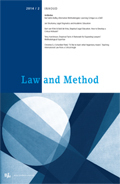|
This paper presents a basic model of the imagination and offers pedagogical resources and activities for educating three related abilities to imagine. The basic model is that to imagine is to combine the process of awareness, framing and distancing, and the process of, simultaneously actively participate, by doing things with and thanks to artefacts. Artefacts, in turn, are fabricated forms (here, forms of language) that signal their own artifice and invite us to do things with them, across a spectrum of sensory, kinetic, and affective abilities. Modelled in this way, imagination plays a crucial role in legal reasoning, and is exemplified by the following kinds of artefacts in legal discourse: fictions, metaphors, hypothetical scenarios and figuration. These artefacts and their related processes of imagination are vital to legal reasoning at many levels, including the level of the individual lawyer or judge, the level of interaction in courtrooms, and the level of legal language over time. The paper offers nine learning activities corresponding to educating three abilities in the legal context: 1) to take epistemic distance and participate; 2) to generate alternatives and possibilities; and 3) to construct mental imagery. |


Law and Method
About this journalSubscribe to the email alerts for this journal here to receive notifications when a new issue is at your disposal.
Found articles
Expand all abstracts
| Artikel |
|
| Keywords | imagination, artefact, active learners, metaphors |
| Authors | Maksymilian Del Mar |
| AbstractAuthor's information |

 November
November